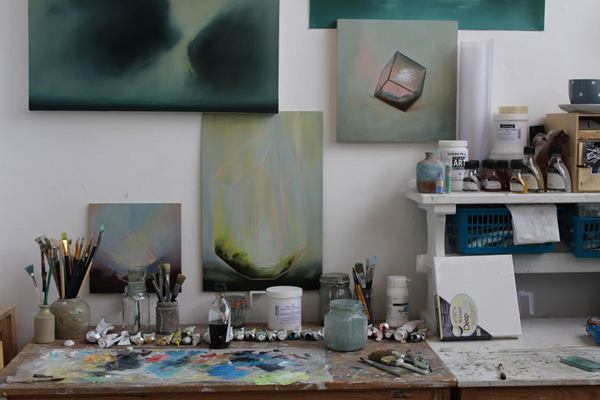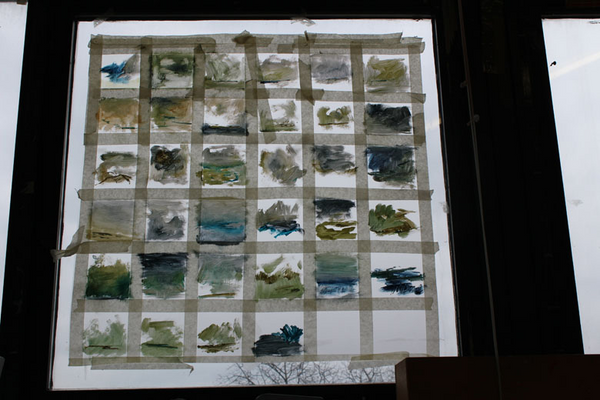Artist Interview: Jemma Grundon

Jemma Grundon is a member of the RWA Artist Network. She studied at Fine Art at Bath University, and has an MA from Goldsmiths University, London. She is primarily an oil painter and works from Jamaica Street Studios, Bristol.
RWA: What are you working on at the moment?
JG: I recently finished an MA at Goldsmiths and moved back to Bristol, and I feel like I’ve been reconnecting with my work since the move. The MA Artist Teacher and Contemporary Practice was very much trying to bridge the gap between pedagogy and contemporary art practice. This idea was new and interesting to me, and I’m still researching ways in which my practice can be part of a visual dialogue. At the time, my work culminated in a bubble installation that involved projectors and recording equipment. Bubbles are fascinating to me – they seem to have an endearing and lasting impact, for something so momentary and fragile.
I’m especially interested in the idea of what we might take away from a fleeting encounter. I came back to Bristol last year, and since then I’ve been, not starting again exactly, but finding a new perspective. It’s been quite challenging as I’ve been really conscious of not just repeating myself – I have been reconnecting with some of the themes behind my work, experimenting with ways of depicting an ephemeral encounter.
For me at the moment it’s very much about pushing things forward, experimenting and finding new ways of conveying my ideas. These paintings (above) are more in keeping with my current ways of thinking; they’re inspired by an interest in terrariums and the idea that there’s a memory or image held in this almost invisible structure. I’m interested in the liminal – the invisible thresholds that exist. It’s that idea I’m playing with – is there a structure there or is there not?
RWA: Where do you find inspiration?
JG: I’ve always found inspiration from the idea of landscape, definitely. I used to paint paintings inspired by the landscape, and I still do from time to time. I love sublime skies and I’m always interested in painting the sky and clouds.
Things that are momentary inspire me – I think that’s where my interest in clouds comes from, because they are a fleeting presence. I have also explored dialogue, chance encounters, bubbles and puffs of smoke – little things that happen. I like the idea that we can’t control these happenings, they just pass, so it’s only the memory of them we’re left with. Perhaps it is that memory that I am trying to contain in the terrarium-like structures. There is a lovely saying I’m very fond of, rooted in Japanese philosophy; ‘mono no aware’, which translated means an awareness of things, with both a transient gentle sadness at their passing, or a sensitivity to ephemera. I’ll always be inspired by that notion.
RWA: What does the RWA mean to you?
JG: I joined the Artist Network when it started. Despite living in London for three years, I kept it ticking over because I knew I would be coming back to Bristol. It’s important to my artistic practice to be part of a network. I like to have a group of people around me, as sometimes painting can be a solitary business. I need that sort of energy around me. It’s the same reason I like being a part of Jamaica Street Artists, and the reason I enjoy collaborative practice.
I also like having the association with the RWA. For me, the building is like a marker in the sand for me in Bristol.
RWA: What would be your dream project?
JG: I would love to produce a series of quite large paintings, that are housed in a really exciting space, like a light-filled room with a glass ceiling, somewhere where the light is engaging with the paintings, like they were specifically painted for the way the light came into the room. I have dreams about doing that one day.
I’d travel more as well, and use the experience of travelling somewhere really remote, where the weather was exciting and the light interesting, like Iceland. I always want to create larger paintings too.
RWA: Who is your hero?
JG: I admire anyone who perseveres with their passion, in spite of difficulties. I think pursuing a passion is sometimes difficult and I’m constantly inspired by all artists that work hard to achieve and produce their work. As far as artistic influences, I really love James Turrell’s work. Every time I see his light installations they knock me sideways. I could immerse myself in his work all day long. I admire Gerhardt Richter too; he constantly shifts his work and it has changed so much over time, but there are always these familiar themes, and he always seems to get it right. My ultimate painting hero would be Turner because every time I see his work it just reminds me of why I paint.
RWA: What’s the best piece of advice you’ve ever been given?
JG: A Tutor at university once told me to always believe in my work, because if I didn’t, you couldn’t expect anyone else to. This advice has stuck, and I strive to produce work that is true to myself and, hopefully, has integrity.
RWA: If you weren’t an artist what would you be?
JG: I really don’t know. I did my Fine Art degree at Bath Spa and then I moved to Bristol. And then I just kept painting – I was fortunate enough to find a studio when I graduated. I used to work in shops and things on a part-time basis. I decided to train as a Teacher of Art because it felt like a way forward and I have always been passionate about the value of art education. I think learning creatively and through visual means is very important, and I do believe that art has benefits for everyone. However, if I wasn’t an artist I don’t think I’d be a teacher because the reason I went into teaching was because of a love of making art.
RWA: If you could own any piece of artwork what would it be?
JG: It would be one of Gerhardt Richter’s Iceberg in Mist I love its melancholic and wistful composition, and the way it’s not a large painting, but it seems to resonate so much with me. I also adore Turner’s unfinished watercolours and oil paintings – some of them don’t even look like anything, just swirling chaos. If I had any money left over, I’d buy a nice Rothko.
RWA: How do you see the future of the RWA?
JG: I see it as an important place in Bristol that continues to exhibit and promote art and a place that gathers people to make art. I love to see galleries that make art more accessible and engaging for all, and where it’s about opening it out to more free and informal ways of showing art too. I get excited by exhibitions that make me think differently or galleries that hang work on the ceilings rather than the walls! I think that’s important for any art institution to push boundaries but maybe particularly for the RWA because it has that traditional starting point – which for me, as a painter using oils, is important. However, I think it’s also important to know where to break traditions and where to keep them.
Continuing to show works of local artists and work with the community is really important too. It’s great that there are places like the RWA that have that capacity.
Jemma Grundon has recently exhibited as part of the Artist Network Exhibition at the RWA. She will also be exhibiting at the annual Jamaica Street Artist Open Studios, from 10th – 12th June 2016.
Gallery






